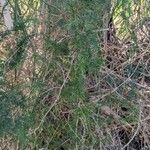Plant erect when stems young, later scrambling and up to 0.6 m or more high. Rhizome typical, bearing thin, rough roots. Stems many, pubescent or glabrous, smooth, green with spreading branches and branchlets, often closely beset with cladode fascicles. Spines straight or reflexed, sharp, reddish brown with the scale leaves above similar in colour, present below branches, branchlets and cladode fascicles. Cladodes ±12 per fascicle, filiform, slightly curved, apiculate, unequally long, the longest up to 10 mm. Flowers up to ±15 cm each cladode fascicle; tepals narrowly obovate, ±3-4 mm long, whitish; stalk ±5 mm long, articulated in lower half. Stamens with small yellow anthers. Ovary with 4 ovules in each locule; obovoid; style and stigmas very short. Berry ±5 mm in diameter, orange.
Erect or climbing or scrambling shrub to 4 m; branches terete to angled, glabrous to pubescent, with spines 3– 5 mm long; terminal branches with or without spines.. Cladodes fasciculate, 5– 25, subulate, stiff or flexible, 3– 15 mm long.. Flowers in fascicles of 2– 10(– 35), axillary and terminal; bracts lanceolate, ± 1.5 mm long, falling off quickly; pedicels 3– 8(– 10) mm long, articulated below the middle.. Tepals white to cream, ± equal, 3– 4 mm long, entire; stamens shorter than the perianth, anthers yellow; ovary 3-locular with 4– 8 ovules in each locule; style 1 mm long, 3-branched.. Berry red, 5– 6 mm in diameter, 1-seeded.. Fig. 1: 1– 3 (page 7).
Erect, spiny shrub, up to 1 m high, or climber, up to 2 m high. Stems pubescent or glabrous, smooth, green. Spines small, straight or reflexed, reddish brown, present below branches, branchlets and cladode fascicles. Cladodes ± 12 per fascicle, filiform, slightly curved, apiculate, up to 10 mm long. Flowers up to 6 in axils; stamens with small yellow anthers; pedicels articulated in lower half. Flowering time Dec.-Feb. Fruit an orange berry.
Erect shrub or scrambler, up to 2 m high. Roots thick, terete. Stems greenish, yellowish or brownish when young, straight, not zigzagging, epidermis not peeling into strips. Spines straight or reflexed, sharp, reddish brown with scale leaves above similar in colour, present below cladode fascicles. Cladodes ± 12 per fascicle, filiform. Flowers: tepals white, Oct. Fruit a berry.
An erect shrub. It can be a scrambler or climbing. It grows 1.7 m high. It has wiry spiny branches. It grows each year from a woody base. The leaves are reduced to very small scales. There are clusters or leaf-like needles in the axils of leaves. The flowers are white or greenish-white. They are borne in the axils. The fruit are small red berries. They turn black when old.
Plant erect when stems young, scrambling later, up to 0.6 m or more high. Spines straight or reflexed, sharp, reddish brown with scale leaves above similar in colour, present below cladode fascicles. Flowers white.
Spiny shrub to 1 m or climber to 3 m, stems with straight or spreading, brownish spines. Cladodes ± 12 in fascicles. Flowers up to 6 in axils, tepals and filaments spreading.
Erect herb 3-5 ft. high with numerous spiny branches
Flowers greenish white









